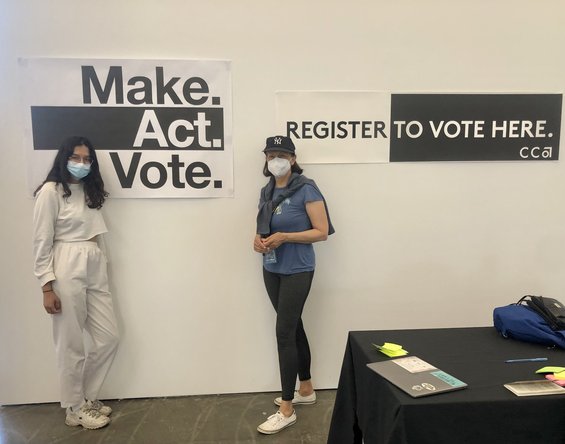A Letter from AnnMarie Giglio, Community Voting Organizer

Dear Fellow CCA Students,
My name is Ann-Marie Giglio, and I am a graduate student at CCA. I became a poll worker because I wanted to serve and I wanted to know first-hand how the U.S. democratic process works. For me, voting by secret ballot is what makes us Americans. You enter the booth as a Democrat or Republican or something else—no one has the right to know—and you emerge as an American. I want to help all Americans vote!
This November 8th, even though we aren’t voting for a president, it’s an important election. We’re choosing our representative in Congress—a Congress that will make key decisions related to our national budget, our military, and our rights. Will it be a Congress that works with the President or against him? We get to vote on that.
Federal funds will be supplied or denied by Congress for things like transportation, health care, education. So, potholes and bridges will or will not be fixed, abortions will or will not be available, libraries will or will not be staffed, schools will or will not have updated heating and ventilation systems, teachers and police officers will or will not have jobs. That’s why deciding these national seats is important.
Closer to home, in every election we also decide local matters, at both the state level and for our own city or town. In California, the state ballot propositions include arts funding, abortion rights, and in-state gambling, all waiting for YOUR vote.
And in San Francisco, our ballot includes questions about affordable housing, libraries, public school funding, deciding on the open or closed status of JFK Drive in Golden Gate Park, public parking and more. We get to vote on that.
Have you ever thought that your vote doesn’t matter because it’s only one? It mattered in 2017.
The votes in one district for House representative in Virginia were so close, they needed to be recounted. Twice. The initial vote count had Republican David Yancey ahead by 13 votes. 13 votes out of 23,215 votes cast. After counting provisional ballots, Yancey’s lead was cut to 10 votes. Following a recount, Yancey trailed challenger Shelly Simonds by one vote. ONE. VOTE.
But it didn’t stop there. A panel appointed by the Virginia Supreme Court had to review the count, and found another ballot for Yancey making the race a tie. A TIE. Because they found ONE VOTE.
On January 4, 2018, the names of each candidate were placed inside a film canister, both canisters were placed in a bowl and one canister was drawn at random by State Board of Elections chairman James Alcorn. Not exactly rock, paper, scissors, but close.
This random draw gave David Yancey the seat, and gave Republicans control of the House 51–49. BY RANDOM DRAW.
If ONE more person had cast a ballot, someone would have won the first time around. Had Simonds won instead, the House would have been in a 50–50 split changing the power sharing arrangement between the two major parties. (BTW, when the two finally met in 2019, in a rematch in a redrawn district, Simonds won.)
DON’T BE THAT ONE MISSING VOTE.
See you at the polls,
—AnnMarie Giglio (MFA Writing)